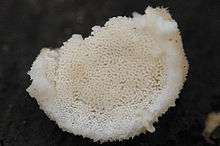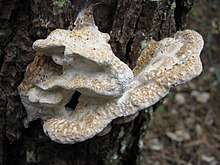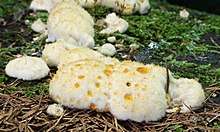Postia
Postia is a genus of brown rot fungi in the family Fomitopsidaceae.
| Postia | |
|---|---|
 | |
| Postia tephroleuca | |
| Scientific classification | |
| Kingdom: | Fungi |
| Division: | Basidiomycota |
| Class: | Agaricomycetes |
| Order: | Polyporales |
| Family: | Fomitopsidaceae |
| Genus: | Postia Fr. (1874) |
| Type species | |
| Postia tephroleuca (Fr.) Jülich (1982) | |
| Synonyms[1] | |
Taxonomy
Postia was circumscribed by mycologist Elias Magnus Fries in his 1874 work Hymenomycetes europaei.[2] The genus name honours Swedish naturalist Hampus von Post (1822–1911).[3]
Species
A 2008 estimate placed 30 species in the genus.[4] As of June 2018, Index Fungorum accepts 57 species of Postia:[5]

Postia guttulata
.jpg)
Postia subcaesia
- Postia africana (Ryvarden) V.Papp (2015)
- Postia amurensis Y.C.Dai & Penttilä (2006)[6] – China
- Postia amylocystis Y.C.Dai & Renvall (1994)[7] – China
- Postia amyloidea (Corner) V.Papp (2015)
- Postia balsamea (Peck) Jülich (1982)
- Postia brunnea Rajchenb. & P.K.Buchanan (1996)[8] – Australia; New Zealand
- Postia caesia (Schrad.) P.Karst. (1881) – Europe
- Postia caesioflava (Pat.) V.Papp (2015)
- Postia calcarea Y.L.Wei & Y.C.Dai (2006) – China[9]
- Postia cana H.S.Yuan & Y.C.Dai (2010)
- Postia carbophila Rajchenb. (1995)[10] – South America
- Postia ceriflua (Berk. & M.A.Curtis) Jülich (1982)
- Postia coeruleivirens (Corner) V.Papp (2015) – East and Southeast Asia
- Postia cylindrica H.S.Yuan (2017) – China[11]
- Postia dissecta (Cooke) Rajchenb. (1988)
- Postia duplicata L.L.Shen, B.K.Cui & Y.C.Dai (2014)
- Postia floriformis (Quél.) Jülich (1982)
- Postia fragilis (Fr.) Jülich (1982) – Europe
- Postia globicystidia P.K.Buchanan & Ryvarden (1998)[12] – New Zealand
- Postia gloeocystidiata Y.L.Wei & Y.C.Dai (2006) – China[9]
- Postia grata (Berk.) Rajchenb. (1989) – Nepal
- Postia guttulata (Sacc.) Jülich (1982) – Europe; India
- Postia hibernica (Berk. & Broome) Jülich (1982) – Great Britain
- Postia immitis (Peck) Niemelä (2009)
- Postia inocybe (A.David & Malençon) Jülich (1982)
- Postia japonica Y.C.Dai & T.Hatt. (2007)
- Postia johnstonii (Murrill) Jülich (1982)
- Postia lateritia Renvall (1992)[13] – Europe
- Postia leucomallella (Murrill) Jülich (1982) – Europe
- Postia lowei (Pilát) Jülich (1982) – Great Britain
- Postia luteocaesia (A.David) Jülich (1982) – Europe
- Postia manuka (G.Cunn.) P.K.Buchanan & Ryvarden (2000)
- Postia mediterraneocaesia M. Pieri & B.Rivoire (2005) – Europe
- Postia minuta Rajchenb. (2001) – Argentina[14]
- Postia obliqua Y.L.Wei & W.M.Qin (2010)[15] – China
- Postia pelliculosa (Berk.) Rajchenb. (1988) – Uganda
- Postia perdelicata (Murrill) M.J.Larsen & Lombard (1986)
- Postia ptychogaster (F.Ludw.) Vesterh. (1996) – Europe
- Postia punctata Rajchenb. & P.K.Buchanan (1996)[8] – South America; Tasmania
- Postia qinensis Y.C.Dai & Y.L.Wei (2009)[16] – China
- Postia rancida (Bres.) M.J.Larsen & Lombard (1986) – Great Britain
- Postia rennyi (Berk. & Broome) Rajchenb. (1993) – Europe
- Postia septentrionalis (Vampola) Renvall (1992)
- Postia sericeomollis (Romell) Jülich (1982) – Europe
- Postia simanii (Pilát) Jülich (1982)
- Postia stellifera T.Hatt. & Sotome (2011)[17] – Malaysia
- Postia stiptica (Pers.) Jülich (1982) – Europe
- Postia subcaesia (A.David) Jülich (1982) – Europe
- Postia subplacenta B.K.Cui (2012) – China[18]
- Postia subundosa Y.L.Wei & Y.C.Dai (2006) – China[9]
- Postia tephroleuca (Fr.) Jülich (1982) – Asia, Europe
- Postia undosa (Peck) Jülich (1982) – Europe, North America
- Postia venata (Rajchenb. & J.E.Wright) Rajchenb. (1988)
- Postia zebra Y.L.Wei & W.M.Qin (2010)[15] – China
In a 2018 revision of the Postia caesia complex, Otto Miettinen and colleagues proposed four new combinations, and described ten new species:[19]
- P. alni Niemelä & Vampola (2018) – Europe
- P. arbuti Spirin (2018) – North America
- P. auricoma Spirin & Niemelä (2018 – Eurasia
- P. bifaria Spirin (2018) – East Asia
- P. caesiosimulans (G.F.Atk.) Spirin & Miettinen (2018) – Holarctic
- P. comata Miettinen (2018) – Northeastern United States
- P. cyanescens Miettinen (2018) – Europe
- P. glauca Spirin & Miettinen (2018) – East Asia
- P. gossypina (Moug. & Lév.) Spirin & Rivoire (2018) – Europe
- P. livens Miettinen & Vlasák (2018) – North America
- P. magna Miettinen (2018) – China; South Korea
- P. populi Miettinen (2018) – Holarctic
- P. simulans (P.Karst.) Spirin & Rivoire (2018) – Holarctic
- P. subviridis (Ryvarden & Guzmán) Spirin (2018) – Europe; North America
- P. yanae Miettinen & Kotiranta (2018) – Eastern Siberia
gollark: No, it's probably not a mere Lagrange interpolation limitation, that would make no sense.
gollark: I forgot how any of this works, and it may just have been entirely based on wikipedia.
gollark: ↓ HIGHLY optimized code
gollark: Unless two points have the same x, although that might just be Lagrange interpolation.
gollark: You can go through n points with a polynomial of degree n. Or n - 1. Or n + 1. One of those.
References
- "Synonymy: Postia". Species Fungorum. CAB International. Retrieved 7 April 2018.
- Fries, E.M. (1874). Hymenomycetes europaei (in Latin). Uppsala. p. 586.
- Donk, M.A. (1960). "The generic names proposed for Polyporaceae". Persoonia. 1 (2): 173–302.
- Kirk, P.M.; Cannon, P.F.; Winter, D.W.; Stalpers, J.A. (2008). Dictionary of the Fungi (10th ed.). Wallingford, UK: CAB International. p. 561. ISBN 978-0-85199-826-8.
- Kirk, P.M. "Species Fungorum (version 28th March 2018). In: Species 2000 & ITIS Catalogue of Life". Retrieved 26 June 2018.
- Dai, Y.C.; Penttilä, R. (2006). "Polypore diversity of Fenglin Nature Reserve, northeastern China". Annales Botanici Fennici. 43 (2): 81–96.
- Dai, Y.C.; Renvall, P. (1994). "Changbai wood-rotting fungi 2. Postia amylocystis (Basidiomycetes), a new polypore species". Annales Botanici Fennici. 31 (2): 71–76.
- Rajchenberg, M.; Buchanan, P.K. (1996). "Two newly described polypores from Australasia and southern South America". Australian Systematic Botany. 9 (6): 877–885. doi:10.1071/SB9960877.
- Wei, Y.-L.; Dai Y.-C. (2006). "Three new species of Postia (Aphyllophorales, Basidiomycota) from China". Fungal Diversity. 23: 391–402.
- Rajchenberg, M. (1995). "New polypores from the Nothofagus forests of Argentina". Mycotaxon. 54: 427–453.
- Yuan, Hai-Sheng; Mu, Yan-Hong; Qin, Wen-Min (2017). "A new species of Postia (Basidiomycota) based on morphological and molecular characteristics". Phytotaxa. 292 (3): 287. doi:10.11646/phytotaxa.292.3.9.
- Buchanan, P.K.; Ryvarden, L. (1998). "New Zealand polypore fungi (Aphyllophorales): three new species and a new record". New Zealand Journal of Botany. 36 (2): 219–231. doi:10.1080/0028825x.1998.9512563.
- Renvall, P. (1992). "Basidiomycetes at the timberline in lapland 4. Postia lateritia n. sp. and its rust-coloured relatives". Karstenia. 32 (2): 43–60. doi:10.29203/ka.1992.291.
- Rajchenberg, M. (2001). "Postia minuta sp. nov. from Southern Argentina". Harvard Papers in Botany. 6 (1): 183–187.
- Wei, Y.L.; Qin, W.M. (2010). "Two new species of Postia from China". Sydowia. 62 (1): 165–170.
- Dai, Y.C.; Yuan, H.S.; Wang, H.C.; Yang, F.; Wei, Y.L. (2009). "Polypores (Basidiomycota) from Qin Mts. in Shaanxi Province, central China". Annales Botanici Fennici. 46 (1): 54–61. doi:10.5735/085.046.0105. JSTOR 23727943.
- Hattori, T.; Sotome, K.; Ota, Y.; Thi, B.K.; Lee, S.S.; Salleh, B. (2010). "Postia stellifera sp. nov., a stipitate and terrestrial polypore from Malaysia". Mycotaxon. 114: 151–161. doi:10.5248/114.151.
- Cui, B.-K.; Li, H.-J. (2012). "A new species of Postia (Basidiomycota) from Northeast China". Mycotaxon. 120: 231–237. doi:10.5248/120.231.
- Miettinen, O.; Vlasák; Rivoire, J.B.; Spirin, V. (2018). "Postia caesia complex (Polyporales, Basidiomycota) in temperate Northern Hemisphere". Fungal Systematics and Evolution. 1: 101–129. doi:10.3114/fuse.2018.01.05. hdl:10138/238584.

This article is issued from Wikipedia. The text is licensed under Creative Commons - Attribution - Sharealike. Additional terms may apply for the media files.
